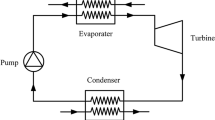
Overview
- Assesses the feasibility of supercritical CO2 radial turbine
- Bridges the gap between mean-line codes and time-consuming full CFD with new tools
- Proposes optimized geometries for radial inflow turbine stators
Access this book
Tax calculation will be finalised at checkout
Other ways to access
About this book
To protect the Earth, China has launched its target of peaking carbon dioxide emissions by 2030, and achieving carbon neutrality by 2060 , which greatly encourages the use and development of renewable energy.
Supercritical CO2 power cycle is a promising technology and the radial inflow turbine is the most important component of it, whose design and optimisation are considered as great challenges. This book introduces simulation tools and methods for supercritical CO2 radial inflow turbine, including a high fidelity quasi-one-dimensional design procedure, a non-ideal compressible fluid dynamics Riemann solver within open-source CFD software OpenFOAM framework, and a multi-objective Nelder–Mead geometry optimiser. Enhanced one-dimensional loss models are presented for providing a new insight towards the preliminary design of the supercritical CO2 radial inflow turbine. Since the flow phenomena within the blade channels are complex, involving fluid flow, shock wave transmission and boundary layer separation, only employing the ideal gas model is inadequate to predict the performance of the turbine. Thus, a non-ideal compressible fluid dynamics Riemann solver based on OpenFOAM library is developed. This book addresses the issues related to the turbine design and blade optimization and provides leading techniques. Hence, this book is of great value for the readers working on the supercritical CO2 radial inflow turbine and understanding the knowledge of CFD and turbomachinery.
Similar content being viewed by others
Keywords
Table of contents (8 chapters)
-
Front Matter
-
Back Matter
Authors and Affiliations
About the author
Bibliographic Information
Book Title: Simulation Tools and Methods for Supercritical Carbon Dioxide Radial Inflow Turbine
Book Subtitle: Development and Application on Open-Source Code
Authors: Jianhui Qi
DOI: https://doi.org/10.1007/978-981-19-2860-4
Publisher: Springer Singapore
eBook Packages: Physics and Astronomy, Physics and Astronomy (R0)
Copyright Information: The Editor(s) (if applicable) and The Author(s), under exclusive license to Springer Nature Singapore Pte Ltd. 2022
Hardcover ISBN: 978-981-19-2859-8Published: 02 January 2023
Softcover ISBN: 978-981-19-2862-8Published: 03 January 2024
eBook ISBN: 978-981-19-2860-4Published: 01 January 2023
Edition Number: 1
Number of Pages: XXXVI, 281
Number of Illustrations: 63 b/w illustrations, 72 illustrations in colour
Topics: Energy Systems, Machinery and Machine Elements, Engineering Thermodynamics, Heat and Mass Transfer, Theoretical, Mathematical and Computational Physics


